M/E/A/N/I/N/G
Online
#2
COLLABORATOR!
I am a loner. Far from wanting to work with others, I prefer working alone or with only a trusted assistant, someone who knows my work habits and is in my employ. I do as much as I can myself; for instance I've only recently adjusted to not stretching my own canvases when I was told they were out of square. And I stopped schlepping them around town myself only when I could no longer carry them up stairs and my wife, Gail, my real collaborator, told me I had to stop.
The truth, of course, is that what we do in the studio, all alone, with a tool and the object we are transforming is collaboration pure and simple. We can no more by sheer will of intellect make something without the mediation forced on us by the very medium we use. The great mystery of paint, or of surfaces in general is how they engage us. It is often easier to get a unanimous vote from a dozen colleagues than to get the necessary moment of truth out of a brushstroke.
I believe in the efficacy of surfaces. The imagination is only as good as its material presence and, if compromised, it can easily lose the artist's intent. I once worked with an artist who was experimenting with aggressive collaborative strategies. In one, each artist erased or recharacterized the other's work until a mongrel was created which, though different than what both might have made alone, satisfied neither. This somewhat interesting experiment might have ended any interest I might have had in collaboration right then and there. It didn't.
FIRST AND ONLY INSTALLATION: 1968
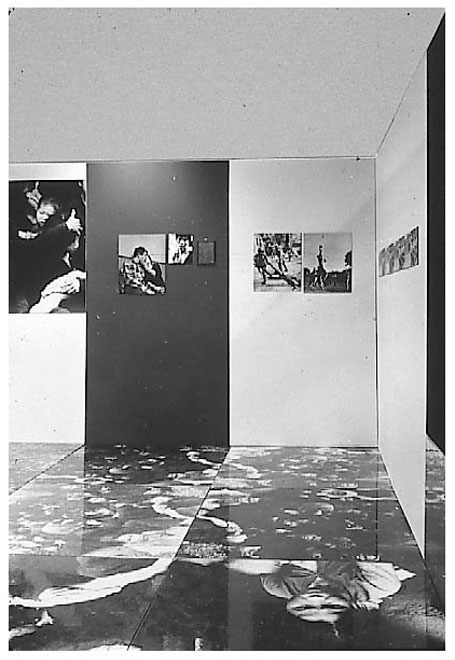 |
|
|
In 1968, I envisioned an anti-war piece called "The American Way Room" (See Jane Holtz Kay, "Artists as Social Reformers," Art in America, Jan-Feb. 1969). It was a photo exhibit of the type that had become ubiquitous during the Vietnam War. It featured the either/or options of battles or picnics, bombing or bathing. What made it different was a deceptively simple connection between the linoleum floor at the beginning of the show and what became an increasingly large photomural of South Vietnamese peasants assembled to be transferred to a new village. I worked with Fred Stone, the originator of what was to become Charette Corporation, who had started a photo-reprographics business in Cambridge. He and I developed a relatively simple system of melding the photo into a pattern which when reduced to a small scale replicated the generic marbleizing in linoleum products. The incremental enlargements at four different places within the exhibit caused a physical response by the viewers who discovered themselves walking on these images of people. As the "originator" of the idea, my job was to keep people focused and raise the money that was needed. The conceptual base is important but without the ability to get people working towards making that idea a reality, it goes nowhere. In that sense practical leadership is as important as imagination.
DANTE
My illustrations for The Inferno of Dante was a lifelong dream that was realized when I collaborated with the poet Robert Pinsky on his translation of the famous first book of Dante's trilogy, The Divine Comedy. This was not my first foray into illustration. I had made an artist's book for my honors thesis at Amherst College, An Image of Salome, in which I had edited and illustrated excerpted interpretations from the biblical story of Salome and Herod in the works of Flaubert, Mallarmé and Oscar Wilde. Later I illustrated Richard Howard's translation of Baudelaire's Fleurs du Mal for the David Godine edition in 1984. But these were not collaborations. In the former, it was the sole product of my labors (assisted by Gail Mazur before we were married) and the later, a contract job—an "adornment," Richard labeled it-- with little or no contact with the poet or publisher.
The Dante work began when I first read the poem in Florence in 1957 during a year abroad. I returned to college to study it in Italian and English and had hoped to do my thesis with this poem but found it too difficult to accomplish in the small amount of time I had to complete it in 1958. I tried it again in etchings in 1968 as another kind of anti-war project but only got as far as four or five plates. The context was wrong and I didn't have a translation that inspired me.
It is rare that an artist looks for an author for a book project. It is usually the other way around. In 1991, several poet friends of mine had written translations or better, new English "versions" of the poem for an anthology of Dante translations. I admired Seamus Heaney's version of Canto 1 and approached him about doing a complete Inferno, which he gracefully declined.
WITH ROBERT
One evening in Provincetown, at the Fine Arts Work Center in April 1992, I listened to Robert Pinsky read from his version—"Englishing," as he calls it-- of Canto 28.
..............................No barrel staved in
And missing its end-piece ever gaped as wide
As the man I saw split open from his chin
Down to the farting-place...
.................................(XXVIII, 22-25)
It was an evening I cannot forget. His reading of it was unexpected. I approached him immediately afterwards to urge him to complete the translation of the Inferno for his publisher, Farrar Straus and Giroux, with my images. It was the right moment for both of us at a time when each of us was ready to take on this task which would take the better part of a year. I had finally found the opportunity I had waited for since 1957.
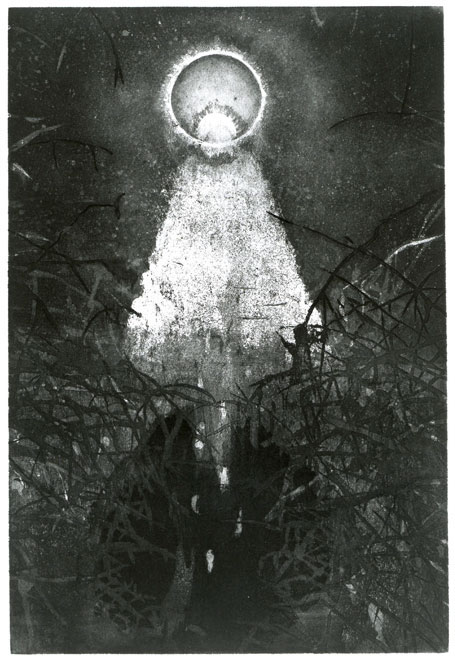 |
|
|
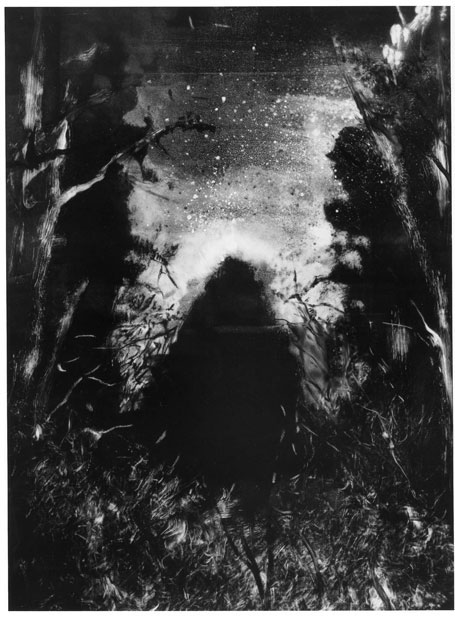 |
|
|
PARALLEL PLAY
At the time of his reading in Provincetown, he had finished only two cantos. Our work therefore was a form of parallel play. Every few days Robert would fax me a translation of a canto and I would excerpt that part of it that suggested an image. I would make studies, always using the monotype medium and from time to time Robert would come over to see the various solutions and we would talk about those that seemed to fail and those that succeeded. Sometimes we might have been satisfied by an example made near the start of the process and at other times many images were pulled before the work was finally resolved. The walls of the studio soon became covered with images and, tacked up next to them, Robert's stanzas.
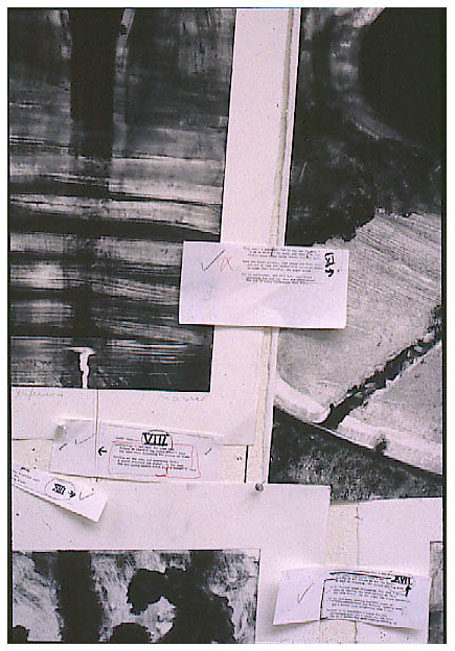 |
|
|
Perhaps the most important agreement between us began at the very inception of our project. It involved the kind of tone we both hoped to convey for the poem. We were both focused on the original. Dante was the visionary after all. We collaborated with him. We are two Jews who saw in the poem not the dogma of the church but a great contribution to the humanistic tradition in literature. We did not see a work about the medieval appetite for the punishment for sins, but an exploration of the nature of sinning, its source and its consequences.
Overall, the tone was one of sadness and loss. This had to be communicated through both language and image. No caricature, no clever retellings with contemporary persona, no dumbing down. Robert and I envisioned a serious work, attentive to the particular narrative and especially to the sense of momentum, the speed of that narrative. Robert found a way to deliver that message by the form of his methods of enjambment and slant rhyme within the restrictions of Dante's Terza Rima.
Monotype is a medium of fluidity of action. Because one works directly with the ink on the plate and can erase and move on or print and rework the plate, it is well suited to redefinition or refinement. Since the plate retains its scale and the quality of the black and white remains consistent, I could choose a solution from any number of possibilities and use that very image for the book.
My approach was to bring the action to the fore by eliminating the traditional images of the two poets in every scene. We see what they saw, not them seeing it, thus quickening the pace and putting the emphasis on the viewer outside the frame. The use of black and white is a primal metaphor. Darkness and light, the mystery of shadows, obfuscation and clarity are all central to Dante's themes.
Often our attempts to stay "on message" were a source of humor between us. Canto 5 was a case in point. I wanted to get around the sentimentality of the traditional portrayal of the illicit lovers, Paola and Francesca, in each others arms for Eternity twisting in the Hurricane of Hell, the punishment for --and characterization for—lust.
...But one particular moment alone was
...Defeated us: The longed-for smile, it said
...Was kissed by that most noble lover: at this
This one, who now will never leave my side.
...Kissed my mouth, trembling. A Galeotto, that book!
...And so was he who wrote it; that day we read
No further."...
Murdered by a jealous husband, that kiss sealed their fate and initially in those lips I thought I saw an image. Detach those lips from their bodies that served them no longer, but the lips...
I parodied the floating lips in Man Ray's famous image. Two mistakes, the parody itself and the multiplied floating lips. Robert's immediate response, acerbic and funny; "The lips, they suck!"
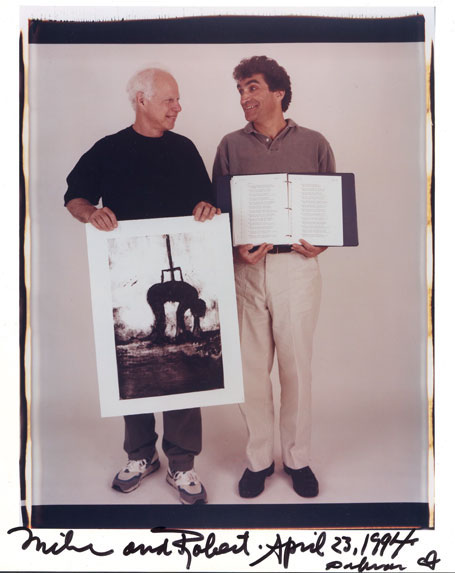 |
|
|
This first part of the story finishes in 1993. As much as I appreciated the wide audience the book gave to the reproductions—it has gone to at least seven editions—what is printed in the FSG edition is a mediocre presentation of the original work done for it. One final set of monotypes remains and is rarely seen. This began to bother me as I felt the real work was misrepresented. I began toying with the idea of an etched version where the original could be seen with an extended amount of text instead of a caption. I made about eleven plates between 1994 and 1999 when I decided to complete the project as an artist's book and publish it myself. An invitation to exhibit it at Castelvecchio in Verona—the castle of Dante's patron Can Grande della Scalla—was the catalyst for this decision.
WITH THE OTHER ROBERT
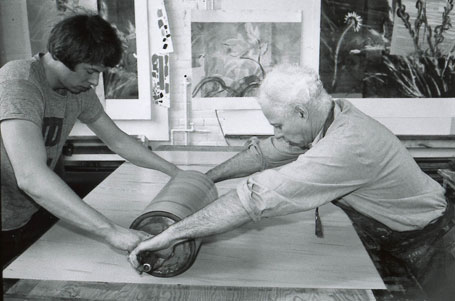 |
|
|
I began working with Robert Townsend in 1983 on a project that truly tested our mettle and our metal!. The Committee for the Visual Arts at M.I.T. commissioned me to do a mural sized work for a new dormitory building. Bob had a press at Impressions Workshop in Boston, which had the potential to print an image as large as 5' wide and 8' long. In other words with a little help we could retrofit his press to be the largest in New England if not anywhere else. It was too much of a temptation not to do this project in monotype. But that is another story and you can see that on a 30 minute tape from M.I.T. called WAKEBY DAY, WAKEBY NIGHT (Wake By Day, Wake By Night, by Daniel Mazur and Susan Chasen). Suffice it to say that doing a unique 6' X 12" print with three 6' X 4' plates took at least eight hours of concentrated work from set-up to printing, based on weeks of preparation making smaller studies. If we could manage that together we could manage anything! We have worked together on projects large and small for twenty years.
Bob's manner lends itself to his job as a master printer. He is quiet and confident and nearly indefatigable. Moreover he is not an artist yet was trained in art school. He has the sensibility without the ego and therefore he adopts himself to whatever aesthetic is provided by the artist with whom he is working. This is no small matter. Anyone who knows what comes from different presses who publish or do contract work, understands that the artist may be the same but the work will look different. From making plates to printing them, each process bears the stamp of the printer.
I have made enough prints in the last forty years to know the difference between working on them in one's own studio and working at a printshop, especially for a publisher. The difference is time and what might be called the aesthetic of the shop. The shorter the time between conception and editing of a print the more chance that its options aren't fully explored. A print grows on you like a painting as it sits around the studio waiting for resolution. Sometimes the freshness of early states is deceiving and begins to pale in a short time.
TEAMWORK
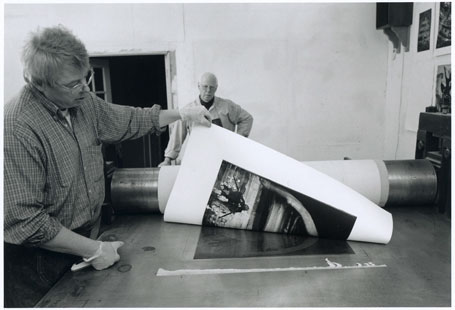 |
|
|
If Robert Pinsky and I engaged in a kind of parallel play in our collaboration, Robert Townsend and I were "teammates." We each brought something to the process. Mine was the vision and the expectation of what the work should look like. Bob brought his technical experience and his equipment. Both were needed to get this done. And getting the work done in time for the Verona exhibit was a crucial part of our collaboration. I have said that I had started etching these images in 1994. My concern was that the etchings have the same tonal heft as the monotypes. Why should I bother to repeat the project if the end result wasn't going to be as strong? I had completed several cantos but now I had to finish the work in a year, about 30 plates! Bob encouraged me to work with Mylar, making the images as I might in a monotype and then transferring these to plates for reworking. Townsend is a master at accomplishing these transfers, which are made using an arc lamp, and a special film that controls the etching of the plate. It is the process used in photogravure, but we used it for the most part as a way to start work on the plate. A photo essay about the process appears in the Catalogue L'Inferno Di Dante, 2000 Electa Editions, Milan.
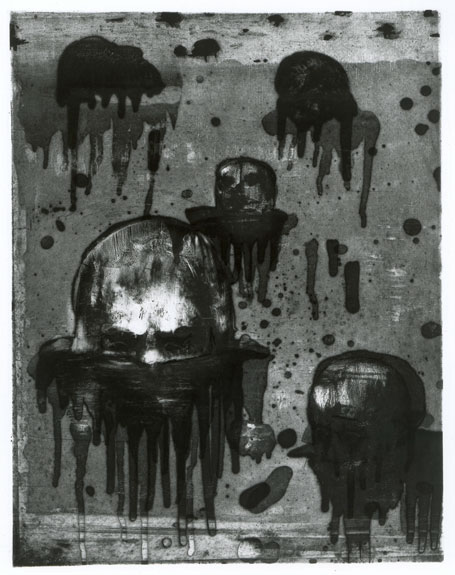 |
|
|
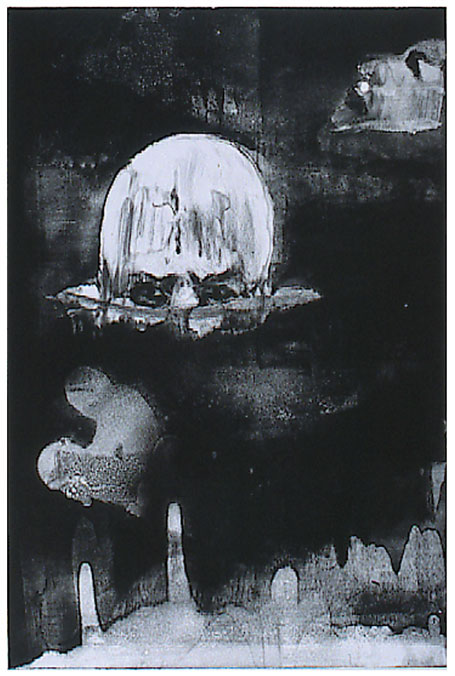 |
|
|
When Robert Gardner made a short documentary called B.A.T.-Good To Pull, about our project, he remarked on how little Townsend and I talked to each other. It was true. After twenty years of working together we tend to know what has to be done and by whom. The process breaks down into the maker and the facilitator. I work the plates; he etches or prints them. I take the proof and decide where to take it. An hour can pass and we say little to each other unless there is a problem to solve and then we exchange ideas. When the plate is finished and a "Bon à Tirer (B.A.T.)" is signed meaning that it is the model for the printer to follow, Bob will steelplate it and edition it alone. The full set of etchings can be seen on the site www.dante-Inferno.net.
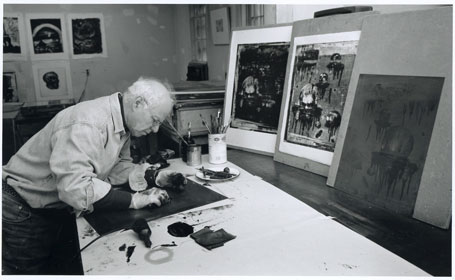 |
|
|
COLLABORATION?
When I think of what pure collaboration might be, I think of people with different temperaments and different skills working together to define a product that no one of them could imagine nor complete by themselves. My son, Dan, and daughter, Kathe, are in the film industry. This is what they and thousands of others do every day. I think of the give and take, and the compromises that result. In this sense I have rarelybeen involved in such a collaboration. What then differentiates my ventures with others from this collaborative ideal? It lies in the authorship and close control of the images, in other words in who's boss.Pinsky and I trusted each other's decisions. We worked in two mediums toward one book We influenced each other in a modest sort of way, each making our own decisions, guided by Dante's words and the images they evoked Townsend and I trusted each other as artist and master printer. In each case our roles were well established and understood
I have said earlier that working with an art object is in itself a form of collaboration, so working with others is a change in degree not in kind. Both are a form of trusting.
Perhaps I have just been lucky to be in those few situations where trust was fulfilled and the work succeeded. But the strength of the initial vision and the ability to follow it through to its conclusion is the reason for that success. That process—call it collaboration—has enriched my life in ways hard to define but easy for me to recognize. I can then disappear back into my studio knowing I am not alone, but then again, I never was.
Michael Mazur is a painter and printmaker who lives in Cambridge, and Provincetown, Massachussetts. More information about the work in this article can be found at www.Dante-Inferno.net.
| Table Of Contents: |
| 01. |